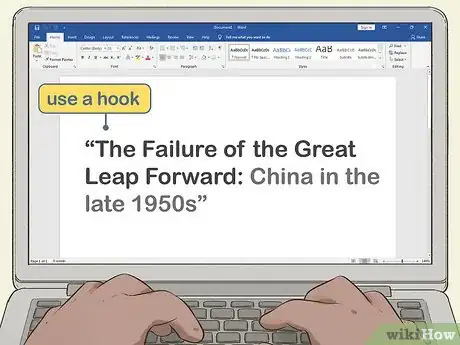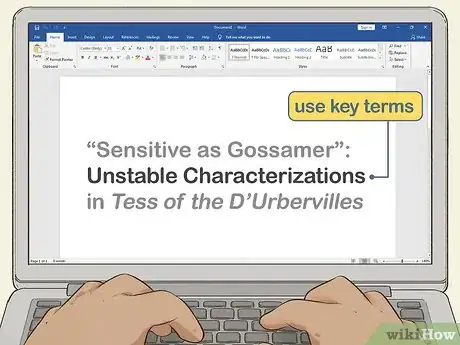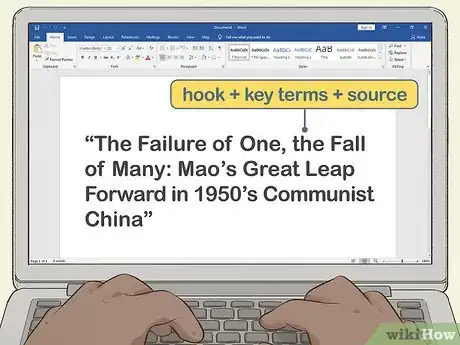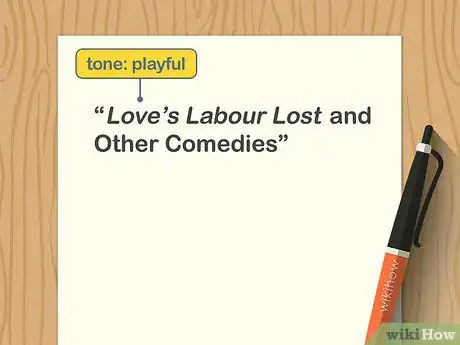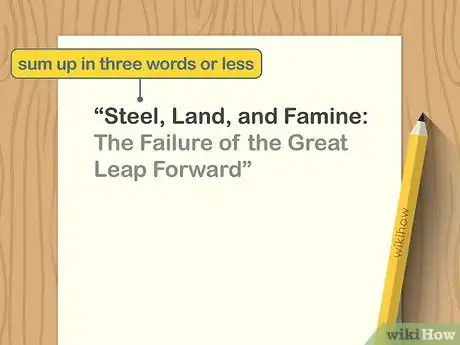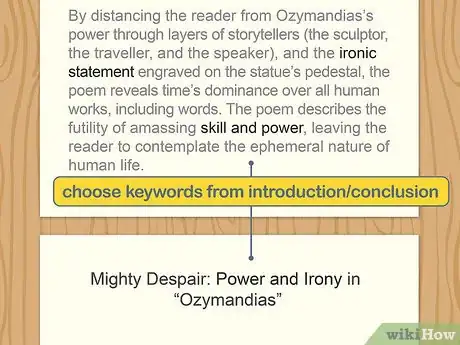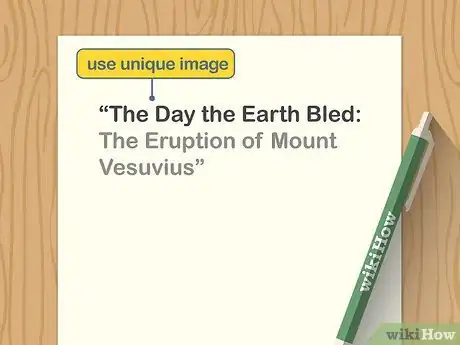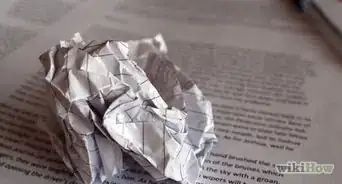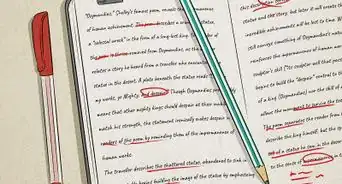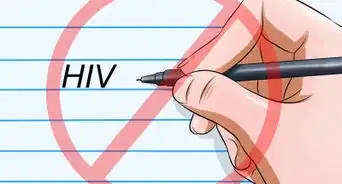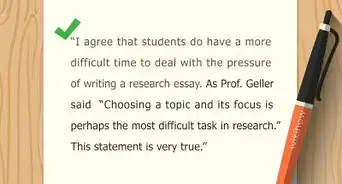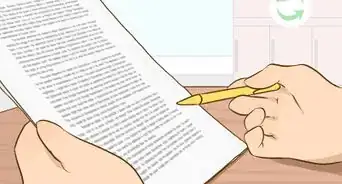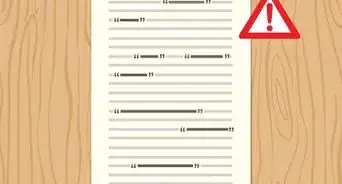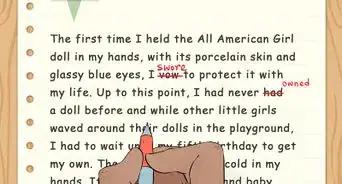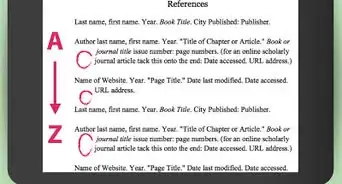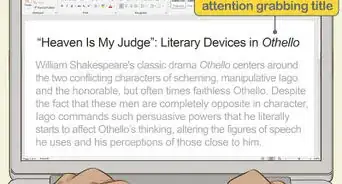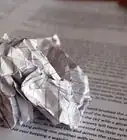This article was co-authored by Stephanie Wong Ken, MFA. Stephanie Wong Ken is a writer based in Canada. Stephanie's writing has appeared in Joyland, Catapult, Pithead Chapel, Cosmonaut's Avenue, and other publications. She holds an MFA in Fiction and Creative Writing from Portland State University.
There are 7 references cited in this article, which can be found at the bottom of the page.
This article has been viewed 1,051,496 times.
Coming up with an effective title can end up being the most difficult part of your essay. A catchy title can make your paper stand out from the pile and give your reader a sense of the content, slant, and perspective of your essay. To craft a strong title, you need to focus on the three elements of a standard title: the hook, the key terms, and the source or location. This structure applies specifically to academic essays, but you can also apply this structure to narrative essays.
Steps
Understanding the Structure of a Title
-
1Craft a hook. Most titles have the same basic structure, especially if the title is for an academic essay. The hook is the creative element that draws the reader in. It’s a catchy phrase that lets the reader know what the essay is going to focus on.[1]
- The hook can be collection of keywords, an image, a play on words, or a quote from your essay.
-
2Choose one or two key terms. These are crucial words or phrases that apply to your topic and give your reader a sense of the content and angle of your paper. These key terms should act like a brief one to two word summary of the essay.[2]
- Keep in mind good titles never state the obvious or contain generic terms or phrases. Titles like “Paper on 1950s China” or “Report on Shakespeare” are too general and do not give the reader a sense of the content of your paper. Avoid general and non specific terms like “society” “culture” “the world” or “mankind” in your title.
Advertisement -
3Cite the source or location. This is the final part of the title that tells the reader where the content is located or what the setting of the essay will be. Depending on your topic, your source material may be another piece of writing, the name of a text, a geographic place or a person.
- For example, a paper about Mao’s Great Leap Forward in Communist China in the late 1950s may have a title that has a hook (catchy phrase), one or two key terms, and the source or location (1950s Communist China). A possible title could be: “The Failure of One, the Fall of Many: Mao’s Great Leap Forward in 1950’s Communist China”.
Using Keywords or Images
-
1Consider the tone of your essay. Is your essay a straightforward, academic essay? Or is it a more free form, narrative essay? If your essay is about the Great Leap Forward in Communist China in the late 1950s, your title may not be a playful or humorous one. It may be more informative and to the point. But if your essay is about the development of Shakespearean comedy in Elizabethan times, you may have a less serious tone for your title. Match the tone of your title to the tone of your essay.[3]
- For example, the title of an essay about the Great Leap Forward might be something simple, professional, and clear, such as: "The Failure of the Great Leap Forward: China in the late 1950s". An essay about Shakespearean comedy may be more playful, such as: "Love's Labour Lost and Other Comedies."
-
2Sum up your paper in three words or less. You can also sum up the thesis for your essay in three words or less. Take out a piece of paper and write down the three words. Then, see if you can place commas or colons between them to create a title.[4]
- For example, an essay about the Great Leap Forward in 1950s China may focus on the failed use of industries like steel and farming by Mao’s government and the resulting mass famine in China. Three words that sum up the paper may be: steel, land, famine. A possible title of the essay could be: “Steel, Land, and Famine: The Failure of the Great Leap Forward”.
-
3Choose two to three keywords from your introduction or conclusion. In a traditional, five paragraph essay, your introduction should include your thesis and the general ideas in your essay. Your conclusion should also restate your thesis and sum up your analysis. Both sections may be good places to find keywords that could lead to a strong title for your essay.[5]
- Look for two to three keywords that are short, descriptive, and clear. Consider if the words fit together in some way, or how they are very different. For example, your introduction on 1950s China may have keywords like “industrialization” “collectivization” and “collapse”. A possible title for the essay could then be: “The Collapse of Collectivization in 1950s China”.
- In an essay on the conventions of Shakespearean comedy, the tone of the essay may be less serious or rigid, and you can look for keywords that are playful or humorous. For example, your conclusion may have keywords like “lovers” “obstacles” and “improbable” or “supernatural”. A possible title for the essay could then be: “Lovers in an Improbable Situation: The Conventions of Shakespearean Comedy.”
-
4Use a strange or unique image. Using the description of an image will give your reader a visual that will then frame the rest of the essay. Think of a bold or striking image that can be summed up in one to three words.[6]
- For example, a paper about a volcano could have the title: “The Day the Earth Bled: The Eruption of Mount Vesuvius”.
Using a Quote or a Play on Words
-
1Look for a key quote or phrase in your essay. A strong essay will use quotations and phrases from source material throughout. Read through the quotes used in your essay for ones that seem particularly strong or powerful. Look for quotes or phrases that sum up your essay as a whole or highlight a central theme or idea in your essay.[7]
- For example, an essay on Shakespearean comedy may quote A Midsummer Night’s Dream, where a character named Theseus professes his love to his betrothed, the Amazonian queen Hippolyta. “Hippolyta, I woo'd thee with my sword/ And won thy love doing thee injuries,/ But I will wed thee in another key,/With pomp, with triumph, and with reveling.”
- A possible title for the essay may then be: “With pomp, with triumph, and with reveling: The Conventions of Shakespearean Comedy”.
- Alternatively, you can look up a key quote or phrase that is not in your essay but reinforces central ideas or themes in your essay. Type keywords from your essay into a search engine, along with the word “quote” and see what comes up. You can then take a fragment of the quote and use it in your title.
- For example, for an essay on Mao’s Great Leap Forward, you may use quotes from propaganda posters for the Great Leap Forward made by the Mao government, which are available online. A propaganda quote like “Brave the wind and the waves, everything has remarkable abilities” could be shortened to a title like: “Brave the wind and the waves: False Promises by Mao’s The Great Leap Forward”.
-
2Reword a cliche. Think of a common phrase or sentence, also known as a cliche, and reword it so it is specific to your essay for a catchy title. Use short cliches or familiar phrases that are one to three words long.[8]
- An essay on Shakespearean comedy could use the cliche “laughter is the best medicine” and change it into “laughter is thy best medicine.” A possible title could be: “Laughter is Thy Best Medicine: The Conventions of Shakespearean Comedy”.
-
3Go for a play on words, or a double entendre. Clever word play can give your title some punch and show that you are willing to be creative. Use an existing phrase and play around with replacing words in the phrase or adding a new spin to the phrase.[9]
- For example, an essay about missionaries in West Africa during the colonial period could have a title that plays on two key words, such as: “Prophets or profits: The European Colonial Invasion of West Africa”.
Community Q&A
-
QuestionDoes anybody have a good idea for a title for a book about depression, murder, and Hollywood?
 Community AnswerHow about "A Show-Stopping Act"? It kind of plays on the idea of a person's performance being "show-stopping," but also the show can't go on because they're dead.
Community AnswerHow about "A Show-Stopping Act"? It kind of plays on the idea of a person's performance being "show-stopping," but also the show can't go on because they're dead. -
QuestionWhat is a good title for an essay on staying drug-free?
 Community Answer"MarijuaNO." Or if puns aren't your thing, "Fight Back the Crack." Or perhaps "No Excuse for Substance Abuse"?
Community Answer"MarijuaNO." Or if puns aren't your thing, "Fight Back the Crack." Or perhaps "No Excuse for Substance Abuse"? -
QuestionWhat could I title an essay talking about challenges that immigrants face?
 Community AnswerYou could use something deep, like "The Path We Face" or "The Pathway To Hope". These titles show a glimpse of what immigrants might experience, emotionally speaking.
Community AnswerYou could use something deep, like "The Path We Face" or "The Pathway To Hope". These titles show a glimpse of what immigrants might experience, emotionally speaking.
References
- ↑ https://www.grammarly.com/blog/how-to-write-a-hook/
- ↑ https://www.ncbi.nlm.nih.gov/pmc/articles/PMC6398294/
- ↑ http://canuwrite.com/article_titles.php
- ↑ https://writing.umn.edu/sws/assets/pdf/quicktips/titles.pdf
- ↑ https://www.grammarly.com/blog/essay-title/
- ↑ http://canuwrite.com/article_titles.php
- ↑ https://libguides.usc.edu/writingguide/title
- ↑ https://education.seattlepi.com/come-up-catchy-titles-college-essays-2131.html
- ↑ http://canuwrite.com/article_titles.php
About This Article
To find a catchy title for your paper or essay, start by thinking of 1 or 2 keywords or phrases to include in the title that applies to the topic of your essay and will hook your reader in. You can also try looking for a key quote or phrase and using part of it in your title. Alternatively, reword a cliche or familiar phrase so that it is specific to your essay. To give your title some punch, use a play on words or double entendre, like “Prophets or profits: The Colonial Invasion of West Africa,” which will show off your creativity. For more tips from our Writing reviewer, like where and how to find good keywords to use, keep reading!
